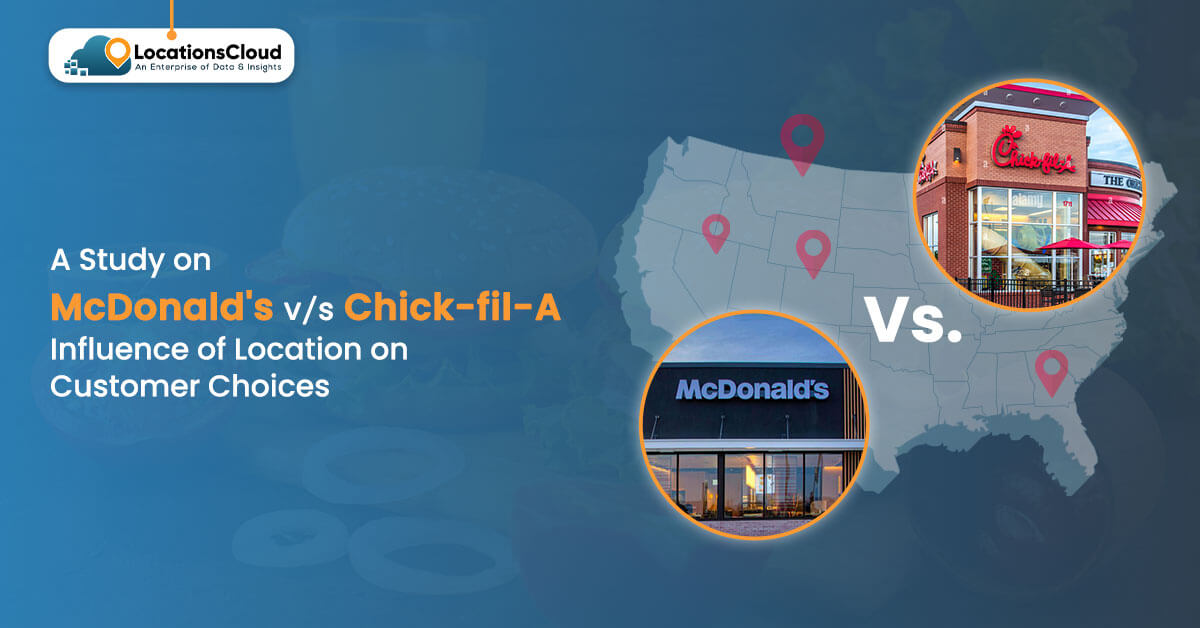
McDonald’s Corporation is one of the leading fast food restaurant companies across the globe, serving burgers like Big Mac, Quarter Pounder, Egg McMuffin and children’s favourite Happy Meal. On the other hand, Chick-fil-A, Inc. is a major American fast-food chain best known for its chicken sandwiches. The purpose of studying McDonald’s and Chick-fil-A locations in the USA is to analyse the geographical distribution, market penetration, and competitive dynamics of two major fast food chains. Researchers can assess customer preferences, urban versus rural market strategies, and regional economic impacts by examining their presence across different regions. This study also aims to identify patterns in expansion strategies, operational differences, and how each brand adapts to local demographics, potentially offering insights into their business success and growth opportunities in the fast food industry.
Understanding the History of McDonald’s and Chick-fil-A
The McDonald’s Corporation originates in Chicago, has grown to become a prime marketing machine that has revolutionised fast food and how this eatery segment is marketed. Starting its journey as a drive-in restaurant in the 40s, McDonald’s went through many transitional phases, established numerous records, and debated controversies on its way to becoming a global fast food chain. Richard and Maurice McDonald’s first restaurant was opened on the 15th of May, 1940, in San Bernardino, California. Initially, it was a car shop known as McDonald’s Famous Barbecue.
The Chick-fil-A started as Dwarf Grill in the 1940s by Truett Cathy, an entrepreneur in Hapeville, a suburb of Atlanta. Based in College Park, Georgia, the company runs over 3,059 restaurants across 50 U.S. states. In addition to its U.S. presence, Chick-fil-A operates in Canada and has previously expanded to the United Kingdom and South Africa. Through the years Chick fil A has adopted unique strategic initiatives such as opening outlets in shopping centres, major sponsoring of college Bowl games and LPGA Tour’s Chick-fil-A Charity Golf Championship, coming up with exceptional and creative advertisements, and, of course, sticking to its Sunday’s off policy.
How many Chick-fil-A Restaurants are in the United States?

Based on the company’s operations, it has 3059 Chick-fil-A restaurant outlets across the United States and was by January 2, 2024. These locations are spread across all 50 states and territories, which makes a statement about the brand’s density. The restaurants are located in 1,446 cities, so customers are provided with an excellent opportunity to taste popular meals offered by the restaurants. Also, Chick-fil-A is popular, confirmed by an average rate of 4.38, meaning customers like it.
Texas
There are 495 locations, which are easily accessible to residents. One unit serves a population of about 58,578 people. The home state of Chick-fil-A, Texas, contributes 16%. It has the highest number of Chick-fil-A stores of all the restaurants in the United States of America.
Georgia
Out of the total number of outlets, 259 are in Georgia, the home of Chick-fil-A, which accounts for 8%. The population density per restaurant is approximately 40,992 people, meaning the restaurants are more convenient for residents than in Texas.
Florida
Florida has 8% of the total locations serving food, with 246 restaurants. Nevertheless, the ratio of people for every restaurant is approximately 87,309 people.
How many McDonald’s Restaurants are in the USA?

According to the latest McDonald’s restaurant location data as of August 26, 2024, 13,562 McDonald’s restaurant outlets are strategically located across the United States. These restaurants are located in 54 states, territories, and 5,052 cities, which shows McDonald’s strong position and capability to serve customers from various market segments. The average rating is 3.46, which suggests mixed customer experience, sometimes positive experiences with the food and service and occasionally negative experiences due to service quality.
California
California alone has 1222 locations, making up 9% of the total outlets. This is a privileged proportion since, with a population of 39.51 million, there are about 32,334 people per McDonald’s restaurant. The above demographic also indicates that consumer preferences in the state may cause McDonald’s to prepare different meals.
Texas
Texas comes next, with 1,171 locations in the United States, which accounts for 9%. It serves 24,782 people per location. The increase in fast food sales in Texas can be attributed to the culture’s preference for convenience, which supports McDonald’s performance.
Florida
Florida has 878 locations, accounting for 6% of the United States. Its population leads to a ratio of 24,462 people per restaurant. The state’s warm climate and year-round tourist influx mean that McDonald’s serves a diverse customer base, further driving its popularity.
Comparison between Chick-fil-A and McDonald’s across the five key factors:
1. Customer Demographics by Location
Chick-fil-A:
- Regional Focus: Strongest presence in the Southern U.S., where it originated. Customers in this region tend to be family-oriented with strong Christian values.
- Age & Income: Appeals to younger demographics like Millennials and Gen Z (age 10-40) and middle- to upper-middle-class families.
- Suburban vs. Urban: More prevalent in suburban and affluent areas, though expanding into urban regions.
McDonald’s:
- Global Reach: It serves a larger population in the United States and other countries. Thus, it works with a wider range of revenue per capita levels, including the lower and middle ones.
- Age Diversity: The restaurant is friendly to all customers, including children and teenagers, with Happy Meals, as well as adults and elderly persons. It’s a favourite among business people and college students in urban areas.
- Rural & Urban: Found both in urban and per-urban environments, although the number of them is higher in cities, and the majority of them can be found in areas of intense human traffic.
2. Customer Preferences and Behavior
Chick-fil-A:
- Quality & Service: Of particular interest is the shift from product attributes, where customers value the quality of clothes more than their cost, to credibility factors, such as persistent communication of brand values like using fresh ingredients and healthier products such as grilled chicken and salads.
- Loyalty: Regarding customer care, one of Chick-fil-A’s major strategies has paid off in brand identification; families and young working adults patronise the restaurant for the food and the experience.
- Religious Influence: One is its decision to be closed on Sundays, a strong move that would appeal to consumers, especially in the regions popularly known as the Bible Belt.
McDonald’s:
- Affordability & Convenience: Its target population is consumers who want cheap food, quick service, and easy accessibility. Economic people most often demand the dollar menu, combo meals, and so on.
- Menu Variety: As the McDonald’s menus offer burgers to salads, the company meets diverse needs, from family dinners or a meal on wheels to midnight snacking.
- Brand Recognition: McDonald’s fast food company is famous for its branding and constant advertisement, which has earned it many casual and loyal customers worldwide.
3. Sales Performance by Location
Chick-fil-A:
- Per-Store Profitability: While Chick-fil-A does not have as many outlets as Mcdonald’s, it has higher sales per outlet than Mcdonald’s. Most Chick-fil-A franchises have above-average revenue compared to what other fast food franchises record.
- Regional Strength: They supplied the brand to the South market and found that it did very well in terms of sales since customers get it from there and keep coming for more. Even in suburban areas outside the South, each store generates high sales volumes.
- Growth in New Markets: In regions like the West Coast and Northeast, where Chick-fil-A has fewer locations, sales are vital as the brand gains a foothold in urban settings.
McDonald’s:
- Global Dominance: With over 38,000 locations worldwide, McDonald’s generates massive sales through sheer volume, especially in high-traffic urban centres and drive-thru locations.
- Dependence on Fast Sales: Volume sales are created by constant calls from customers who cherish quick service by ordering small portions quickly, most especially at the beginning, middle, and end of the day (breakfast, lunch).
- International Markets: McDonald’s does notably well in international markets. Its menu is altered for each country, offering rice meals in Asia or vegetable burgers in India.
4. Marketing Strategies related to Location.
Chick-fil-A:
- Community Engagement: Marketing is about the trust-making process and promoting family values. It aids fundraising events, educational institutions, and charitable organisations, preferably in the southern region.
- Social Media & Digital: They rely on social media and application-based promotions with young people to increase their clientele through loyalty and mobile ordering issues.
- Targeted Expansion: The brand doesn’t rush into urban markets to compete with the highest-speed fast food companies but focuses on quality service delivery.
McDonald’s:
- Mass Appeal Advertising: The burger giant uses international campaigns that are familiar worldwide (for instance, “I’m Lovin’ It”). They tailor advertisements to local cultures but focus on convenience, fun, and affordability universally.
- Localised Menus: McDonald’s customises its menus based on regional preferences. For instance, restaurants in large cities offer healthier meals, such as salads, while restaurants in rural areas specialise in basic meals, such as burgers and fries.
- Celebrity Partnerships: In large cities and towns, McDonald’s makes celebrities and famous bloggers easily accessible by attracting them with location-specific marketing strategies.
5. Challenges and Opportunities
Chick-fil-A:
Challenges:
- Cultural Perception: This fast food chain struggles in more progressive areas thanks to its very conservative outlook and stated positions on matters of sexuality. This can help slow down its expansion in areas where it exceeds the capacity of customers it appeals to in terms of brand values.
- Limited Global Presence: Chick-fil-A’s chief issue is that it is still predominantly an American company, and globalisation raises operational and cultural concerns.
Opportunities:
- Urban Expansion: The target markets that seem to offer significant growth prospects are those located in urban centres, where one finds the population of young and professional people who have a propensity to go for quality and service. Some growth opportunities are still visible in the expansion of the West Coast and Northern Eastern markets.
- Health-Conscious Menu: Chick-fil-A’s health-conscious catering sets it up for long-term success as fast food moves towards better-for-you alternatives.
McDonald’s:
Challenges:
- Health Trends: The increase in the number of consumers willing to eat healthily puts McDonald’s in the spotlight and offers pressure to transform its menu and change its branded food products to be healthier.
- Competition: New fast-casual restaurants such as Chipotle and Panera are five times more challenging regarding quality and personalisation, especially in urban markets.
Opportunities:
- Global Expansion: McDonald’s has growth opportunities, with the key areas being the Asian and African markets because of the established brand and menu versatility.
- Sustainability and Innovation: McDonald’s current strategy to target plant-based products, eco-friendly packaging, and the incorporation of technology in fast food through kiosks and delivery may appeal to the shifting culture of green and smart solutions.
Conclusion
The positioning of McDonald’s and Chick-fil-A has a significant influence on the customers and their choices. These three aspects enormously impact the consumer, and each chain uses its positioning schemes to capture the desired markets. McDonald’s accessibility in both urban and rural areas gives it an advantage that can cover a wider audience; at the same time, Chick-fil-A is more specific in its locations, often in urban suburbs and highly frequented areas. In this study, the chosen geographical locations affect not only the efficiency and profitability of these fast food chains but also the unique positioning and strength in the market each of these companies maintain through offering convenience and appeal.
The target customer segments of Chick-fil-A and McDonald’s are quite different, and depending on the region, the challenges and opportunities vary. Chick-fil-A survives on the quality of its services and appreciation of the community, while McDonald’s has established itself in having scale, convenience, and global access.


